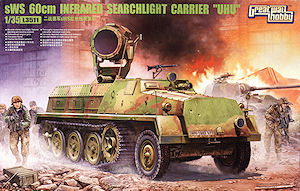
sWS 60cm Infrared Searchlight Carrier 'UHU'
Great Wall Hobby 1:35 kit #L3511
Review by Terry Ashley
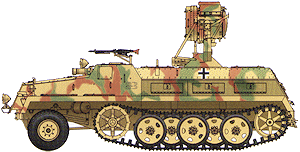
The initial unarmoured cargo version was produced by Büssing-NAG from December 1943 till the end of the war with a total of 825 produced; this was continuing post-war by Tatra in Czechoslovakia.
The sWS was powered by a 6 cylinder, water-cooled Maybach HL42TRKMS gasoline engine generating 100 horsepower (75 kW) which gave it a top speed of 27 klm per hour (17.0 mph) on good roads with a load capacity of 4,000 kilograms (8,800 lb).
Later types featured an armoured cab and engine compartment looking similar to the Sd.Kfz.251 with fold down sides for the rear cargo bay. The armoured sWS was also used in two other configurations, one fitted with the 3.7cm FlaK 43 anti-aircraft gun on the rear bed and the Panzerwerfer 15cm Nebelwerfer 42 rocket launcher mounted over an armoured ammunition storage compartment built over the cargo area.
We should first clear up a few issues regarding this label as there is no documented evidence the IR equipped sWS was either contemplated or produced in drawing or prototype form and can’t really even be called a “paper panzer”. This configuration probably gained some credence from the old ROCO 1:87 scale metal sWS IR but is purely science fiction and would look good posed next to MIG Productions KV2 walking tank or any of the Dust series of sci-fi equipment.
Interestingly the head of German IR development Dr Gaertner lectured on the equipment (as part of the NATO scientific community) well into the 1970's.
Also the name “UHU” was a specific name given to the Sd.Kfz.251/20 and not a generic name for IR equipped vehicles the same as the name “Gepard” is not correct when used to describe the Flakpanzer 38(t).
With that in mind I will review this kit in two parts, firstly looking at the base armoured sWS vehicle and then at the 60cm Infrared Searchlight included in the kit which could come in handy for other uses.
The kit has 403 parts in light beige plastic with another 472 individual track links in the same beige plastic plus 11 clear and 67 etched parts on 11 sprues and one metal fret. Added to this are the decal sheet and 11 page instruction booklet and following AFV Club’s lead there is also a colour poster of the box art included should you wish to frame this?
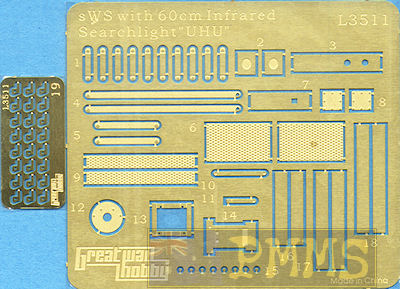
The quality of the moulding is excellent with clean crisp details virtually free of any flash or pin marks and any present is quite minor and easily dealt with. There are the usual mould seam lines to be removed and as some of the parts are extremely small and fine you will need to take care removing these from the sprues and during assembly.
Dimensionally the kit measures up very well against the 1:35 plans in the Tank Magazine and Panzer Tracts No.12 listed below with parts such as the running gear, track and hull widths being spot on. There are a few discrepancies in the lengths of the armoured cab/engine compartment and rear armoured hull ‘box’ compartment but there is also disagreement on these dimensions between the plans with the kit matching parts of one plan and parts of the other. So overall it sort of evens out and the kit certainly doesn’t look out of proportion in any way compared the available photos.
The kit is basically what we will see in the sWS 15cm Nebelwerfer 41 kit to follow with just the 60cm IR searchlight and other IR scopes instead of the Nebelwerfer launcher mounting and so serves as a good preview to that kit.
Included in the kit is a number of options including two styles of front wheel rims, two sizes of drive sprocket, the initial large and later smaller diameter sprocket as well as two styles of idler wheels, the initial spoked idler and the solid disc idler with the early style full dish road wheels.
The kit is also broken down into sub-assemblies which can be built separately and brought together at final assembly which allows you to work on one while the glue/paint dries on another and this helps speed up assembly. The sub-assemblies are the lower chassis/suspension, forward armoured cab/engine compartment, rear armoured “box” and the 60cm IR searchlight assembly.
These channels fit neatly inside the chassis without any problems and there is also a detailed 5 part winch, 3 part fuel tank, a couple of bulkheads and two air tanks added inside the chassis as well as a 5 part winch cable guide. This guide has three very small roller wheels trapped between the two sides and removing these rollers from the sprue and fitting will really test you patience as well as eyesight. Considering none of these chassis parts can be seen after the rear armoured box is fitted you could probably save yourself a fair bit of work by just eliminating the parts, it’s your choice. It should also be noted that the winch was not fitted to Armoured sWS types that did make production so we can assume it wouldn't be fitted on this vehicle either.
Added to the chassis side are the 5 axles per side which have subtle cast texturing on the arms and you have to be careful removing the moulding seams so not to eliminate the texturing, the arms are hidden by the road wheels anyway so it probable doesn’t matter a lot?
The axle arms have a small pin to ensure they are all aligned correctly in the neutral position and if you wanted to articulate the suspension you just cut off the pin and reposition the arm.
At the back the idler axle mounting has a separate threaded adjustment bolt that fits through the hull bracket with a separate tensioning bolt and gives very good definition to the mounting.
There is also a three part towing pintle, boarding step and compressed air valve as well as the towing pintle on the front of the chassis with separate pin.
The remainder of the assembly is fairly straightforward but a little fiddley so take care to get everything in the right position and the assembled suspension unit then fits neatly into the locating holes on the bottom of the chassis.
There are 4 steering linkages added to the left side of the chassis and as we have seen on some other kits these are not designed to be movable and once glued in place negate the workable steering?
This does allow you to position the front wheels at any angle as you glue the linkages for a bit of animation and it’s also a simple task to modify the steering linkages to make these workable for truly workable suspension if you wish.
This entails cutting the locating pins from the parts to fill the corresponding locating holes and when dry drill holes for the thin plastic rod pins (I used 0.6mm plastic rod) added to the appropriate places on the linkages. You then slip the pins through the holes and secure by heat melting the ends of the pins which results in fully workable steering. See images.
The front wheels have alternate hubs with subtle differences in the details such as rim bulge and number of lightening holes with both types seen in photos of the sWS so there is no real preference here as either can be used. The tyres are in six sections each which are sandwiched together to for excellent representations of the tread pattern but you have to ensure the segments are put in the right order and also you should squeeze these together tightly when gluing to eliminate any gaps.
The hubs are a nice tight fit inside the tyres when assembled with the final wheels looking excellent with the well defined tread pattern; the only thing missing is any tyre side wall embossing but apart from that are very well done wheels.
Each drive sprocket is made up of three plastic parts and care is needed to clean up the mould seams inside the outer disc spokes and you need to watch the tooth alignment when gluing the inner and outer sprocket discs together.
There are two locating pins between the two sprocket halves and you should test fit these as the teeth only align with the pins one way, if you fit the pins the other way the teeth don’t align so make sure you get the two dish halves aligned correctly before gluing.
Added to the sprockets are etched step rings around the central hub and these have tread plate texturing on both sides for a good impression. It’s best to bend the etched part around a suitably sized drill bit shaft and to solder the ends together for a stronger join, cyanoacrylate just won’t hold in this situation.
The soldered ring can then be added to the sprocket hub with the fit being spot on making for a snug fit and this adds excellent definition to the sprocket hub.
As mentioned there two sizes of drive sprockets supplied in the kit and the majority of reference photos of the sWS show the larger sprocket with only one shot I found with the smaller sprocket. This does show both were used but it appears the larger is far more common, it also looks better IMHO.
The road wheels are the early solid dish type with 5 small cut-outs and these are well done with excellent hub details and good dish profile. Assembly is quite straightforward but I did have to enlarge the locating hole on the inside of the outer wheel (parts A25) slightly to better fit over the end of the axles. You just need a couple of twists of a 1mm drill bit to enlarge the hole but be extremely careful you don’t drill right through the outer wheel hub in the process.
At the back are alternate 2 part idler wheels, the initial spoked type and the later solid dish type with references showing the spoked type are more commonly seen so check if you are building a particular vehicle as to the idler type used.
Detail on the track links is very well defined but there are some small pin marks on the inside of the alternate links without the guide teeth but these seem to disappear after assembly and are not at all obvious on the links I glued together for this review.
While the links are not workable they are large enough for you to drill and add a 5mm wire pin at each side to make them workable if you wished. Or if you have a set of Friul metal sWS tracks (set #ATL44) these should also fit as the Italeri sWS sprockets are the same size and tooth pitch as the sprockets in this kit.
The engine firewall has details included on both the engine and cabin side with a separate horn on the engine side and separate instrument panel with decal dials, radio and small lever box with three very small levers added to the driver’s side as well as the three separate foot pedals and three gear levers for a fairly well populated compartment. The seats are in three parts each and the floor has subtle tread plate included and there is additional equipment added to the sidewalls such as junction boxes and an MP40.
The two forward visors have separate 4 part inner brackets which allow these to be positioned open or closed depending on your preference?
Added to the fenders are the pioneer tools with moulded on clips, the two front head lights with separate base and two part light, the width indicator posts with a mirror on the left post plus the Notek light with etched bracket.
Under the left fender is a three part exhaust muffler with the end of the short pipe hollowed out for a better appearance and two bumper bars are added to the front.
There are two small armoured “wings” added to the front plate and you should test fit this to the engine compartment to ensure these are glued at the correct angle.
All the panels fitted perfectly without the need for any trimming and the central engine doors can be shown open or closed if you wish and it’s all ready for a resin engine from the likes of CMK or SKP?
One notable detail on the engine doors is the 4 large intake louvers on the left door are moulded open for a very good appearance and the two part roof hatch is free of inner pin marks and can also be shown open or closed as can the driver’s visors as mentioned above.
The fit of the upper armoured cab to the lower fenders is very good with small locating pins resulting in no filler or trimming being required.
On the inside are the inner storage locker walls that also form the inside compartment walls and while the location is very precise due to the large locating ribs fitting the walls to the lower fenders is very important to the final fit of the rear and roof plates.
Added to the inside of the walls is a couple of forward storage lockers and radios on the left side as well as the V shaped reinforcing ribs with much of this detail being pure conjecture but you can’t see this anyway so is not really an issue.
The rear panel has the two entry doors separate and these have additional small handles added and again these can be shown open if you wish but it’s probably best to leave these closed.
The fit of the rear plate to the assembled compartment was good but this will depend very much on the fitting of the side walls as mentioned so test fitting the rear panel while the side wall glue is still tacky would be an advantage for the best fit.
You should note not to fit the roof at this stage as you have to fit the IR searchlight and turret basket to the roof before attaching the roof to the compartment, but more on this later.
The roof has separate twin hatches forward and aft of the turret ring and these have inner latches as well as being free of pin marks should you want to show these open. It should be noted that the roof layout and small octagonal turret are those from the Nebelwerfer sWS used here for this kit.
Fitting both the armoured engine compartment/cab and rear armoured superstructure to the lower chassis is very straightforward with a good fit not requiring any trimming, just ensure these are aligned correctly with the chassis as there are not actual locating lugs or pins.
The 60cm searchlight is almost identical to that included on the AFV Club Sd.Kfz.251/20 “UHU” (kit #AF35116) and the 60cm Flakscheinwerfer (Flak-Sw 36) (kit #AF35125) with basically the same part breakdown and details. The only differences being some small detail items like the wing fasteners being etched parts in this kit and plastic in the AFV Club kits.
The main body is in two halves to which is added numerous smaller detail parts including small etched wing nuts and plastic grab handles that require care in handling, note the grab handles located closest to the front should be moved about 1mm further forward to clear the mounting yokes but other than that everything fitted well.
The large front ring has added inside the clear plastic lens and six etched louver strips, these are best attached using white glue to avoid disasters if using cyanoacrylate. Added around the outside of the ring are more of the miniscule etched wing nuts and fine plastic handles and again care is needed when fitting these. It’s best to slightly drill out the locating holes for the etched wing nuts to provide a more secure footing.
The outer lens ring cover again has a inner clear disc and even more of the etched wing nuts and fine plastic handles, you should note that to fit the outer ring cover the height of the small grab handles (parts E14) on the front of the main ring will need to be reduced to allow the front cover to fit. You may want to leave these grab handles off altogether if fitting the outer cover to make things easier.
The support U shaped yoke is in two halves with smaller plastic and etched parts added as well as the two rear arm supports and its best not to glue this to the lower turret mounting bracket (parts E11, E12, E42) at this stage to make final assembly easier.
As mentioned the octagonal turret from the Nebelwerfer sWS is used and this has nice weld seam texturing on the outer joins and also the inner traverse and elevation hand wheels again being from the Nebelwerfer sWS layout.
Inside is a small turret basket with two support arms and an operator’s seat as well as support for the small IR Scope protruding from the front of the turret. The proximity of the seat to the turret ring and junction box added to the basket make it impossible for a Human to actually sit on the seat unless they consist of a torso only which is probably due to Sci-Fi nature of the setup.
But if you build the kit with all the hatches closed this can’t be seen so would be a moot point in that case anyway and is probably the best way to finish the model?
To add the turret and inner basket to the roof plate you have to feed the basket arms through the roof turret ring to mate with the locating lugs inside the turret, this is because the turret basket will not fit through the turret ring if you were to fully assembly the searchlight/basket assembly before hand.
Once you have secured the turret and basket to the roof (don’t actually glue the turret to the roof) you can then fit the roof to the rear compartment and then attach the searchlight assembly to the turret support bracket.
Finally there is a large etched arm added between the turret and searchlight and this is rather tricky to fit as the joins between the plastic mounting pin and the etched arms are just butt joins which are not very robust. The arms are actually in two halves which you join together for added strength and it’s best to solder these together to avoid the coming apart if using cyanoacrylate.
I choose to replace the plastic mounting pin with a small section of real metal pin that allowed me to solder this to the etched arm ensuring it would not break off which made fitting in place a whole lot easier.
Referring back to the turret basket not fitting through the roof turret ring another alternative is the trim the corners off the basket mounting posts (parts E18, E19) which will allow the basket to slip through the turret ring which in turn allows you to fully assembly the searchlight/basket assembly separate from the roof for a much easier exercise.
As the inside basket can’t be seen after assembly with the hatchers closed this won’t be an issue and will make the assembly easier, see the images where I have trimmed the posts as described.
Added to the front of the armoured cab are the Driver’s IR Scope with 4 parts mounted on a 2 part etched bracket and two small IR spot lights again with etched mounting brackets. There is no wiring provided for any of the IR equipment and the placement and items included is again just conjecture.
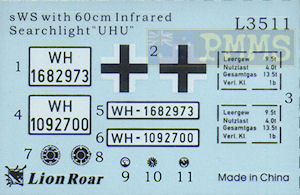

There is very little cleanup required and the fit of the parts very good overall with the front wheels and running gear/track being especially well done along with the driver’s compartment interior.
The 60cm searchlight itself is very well detailed and the overall appearance of the model is very impressive due to the overall quality of the parts and finer details.
The sWS itself is a marked improvement over the aging Italeri offering and bodes very well for the remaining sWS kits in the series to come from Great Wall Hobby and many will simply overlook the sci-fi nature to build a very impressive looking kit.
Despite this sci-fi nature of the subject I’m still rating the kit highly recommended due to the overall quality of the kit.
Click on thumbnails for larger view









Detail images




Close new window to return to review
| Büssing's schwerer Wehrmachtschlepper (sWS), armored and unarmored variants Nuts & Bolts Vol.41 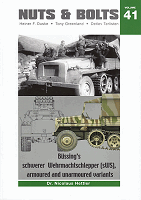 |
mittlerer Zugkraftwagen 5t (Sd.Kfz.6)
and Schwerer Wehrmachtsschlepper Panzer Tracks No.22-3 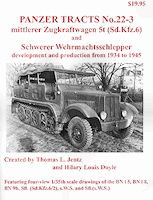 |
Halftrack Vehicles of the German Army 1395-1945 Schiffer Military History ISBN: 0-88740-758-7 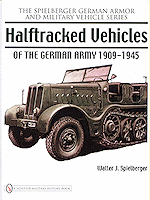 |
German Medium Half-Tracked Prime Movers 1934-1945 Schiffer Publications ISBN: 0-7643-0263-9 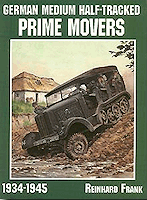 |
Thanks to Lion Roar/Great Wall Hobby for the review kit.

